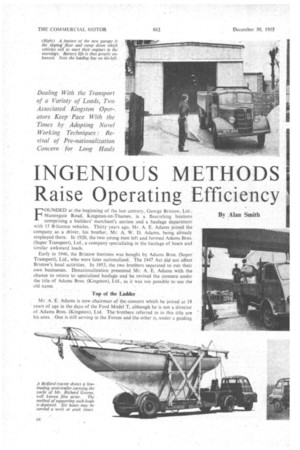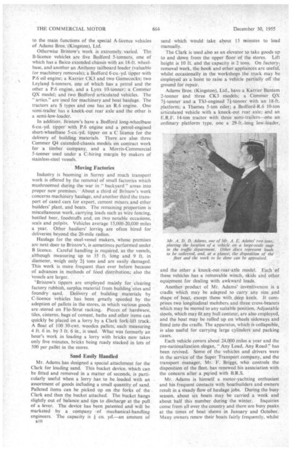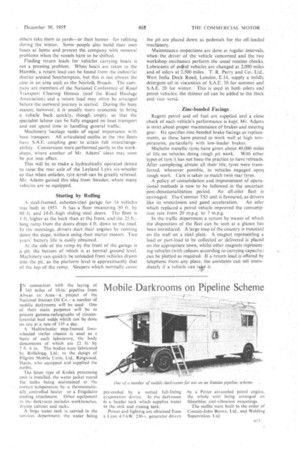INGENIOUS METHODS Raise Operating Efficiency
Page 42

Page 44

Page 47

If you've noticed an error in this article please click here to report it so we can fix it.
FOUNDED at the beginning of the last century, George Bristow, Ltd.. Manorgate Road, Kingston-on-Thames, is a 'flourishing business comprising a builders' merchant's section and a haulage department with 15 B-licence vehicles. Thirty years ago, Mr. A. E. Adams joined the company as a driver, his brother, Mr. A. W. D. Adams, being already employed there. In 1920, the two young men left and formed Adams Bros. (Super Transport), Ltd., a company specializing in the haulage of boats and similar awkward loads.
Early in 1946, the Bristow business was bought by Adams Bros. (Super Transport), Ltd., who were later nationalized. The 1947 Act did not affect Bristow's local activities. In 1953, the two brothers separated to run their own businesses. Denationalization presented .Mr. A. E. Adams with the chance to return to specialized haulage and he revived the concern under the title of Adams Bros, (Kingston), Ltd., as it was not possible to use the old name.
• Top off the Ladder
Mr. A: E. Adams is now chairman of the concern which be joined at 18 • years of age in the days of the Ford Model T, although he is not a director of Adams Bros. (Kingston), Ltd. The •brothers referred to in this title are his sons. One is still serving in the Forces and the other is, under a guiding to the main functions of the special A-licence vehicles of Adams Bros. (Kingston), Ltd.
Otherwise Bristow's work is extremely varied. The B-licence vehicles are five Bedford 5-tonners, one of which has a Baico extended chassis with an 18-ft. wheelbase, and another an Anthony tailboard loader (valuable for machinery removals); a Bedford 6-Cu.-yd. tipper with P.6 oil engine; a Karrier CK3 and two Gamecocks; two Leyland 6-tonners, one of which has a petrol and the other a P.6 engine,. and a Lynx 10-tonner; a Commer QX model; and two Bedford articulated vehicles. The " artics." are used for machinery and boat haulage. The tractors are S types and one has an R.6 engine. One semi-trailer has a knotk-out rear axle and the other is a semi-low-loader.
In addition, 13ristow's have a Bedford long-wheelbase 6-cu.-yd. tipper with P.6 engine and a petrol-engined short-wheelbase 5-cu.-yd. tipper on a C licence for the delivery of building materials. There are also three Commer Q4 extended-chassis models on contract work for a timber company, and a Morris-Commercial 5-tonner used under a C-hiring margin by makers of stainless-steel vessels..
Moving Factories
Industry is booming in Surrey and much transport work is offered by the removal of small factories which mushroomed during the war in " backyard " areas into proper new premises. About a third of Bristow's work concerns machinery haulage, and another third the transport of cased cars for export, cement mixers and other builders' plant, and boats. The remaining proportion is miscellaneous work, carrying loads such as wire fencing, bottled beer, foodstuffs and, on two notable occasions, seals and pulpits. Vehicles average 15,000-20,000 miles a year. Other hauliers' lorriq are often hired for deliveries beyond the 20-mile radius.
Haulage for the steel-vessel makers, whose premises are next door to Bristow's, is sometimes performed under , B licence. Careful handling is required, as the vessels, .although measuring up to 35 ft. long and 9 ft. in diameter, weigh only 2/ tons and are easily damaged. This work is more frequent than ever before because of advances in methods of food distribution; also the vessels are larger.
"Bristow's tippers are employed mainly for clearing factory rubbish, surplus material from building.sites and foundry sand. Delivery of building materials by C-licence vehicles has been greatly speeded by the adoption of pallets in the stores, in which various goods are .stored on Flo-Strut racking. Pieces of hardware, tiles, cisterns, bags of cement, baths and other items can quickly be placed on a lorry by a Clark fork-lift truck. A float of 100 30-cwt. wooden pallets, each measuring 4 ft. 6 in. by 3 ft. 6 in., is used. What was formerly an hour's work in loading a lorry with bricks now takes only five minutes, bricks being ready stacked in lots of 500 per pallet in the stores.
Sand Easily Handled
Mr. Adams has designed a special attachment for the Clark for loading sand. This bucket device, which can be fitted and removed in a matter of seconds, is particularly useful when a lorry has to be loaded with an assortment of goods including a small quantity of sand. Palleted items can be picked up on the forks of the Clark and then the bucket attached. The bucket hangs slightly out of balance and tips to discharge at the pull . of a lever. The device has been patented and will be marketed by a company of mechanical-handling engineers. The capacity is / cu. yd.—an amount of sand which would take about 15 minutes to load manually.
The Clark is used also as an elevator to take goods up to and down from the upper floor of the stores. Lift height is 10 ft. and the capacity is 2 tons. On factory removal work, the hook and other appliances are useful, whilst occasionally in the workshops the truck may be employed as a hoist to raise a vehicle partially off, the ground for repair.
Adams Bros. (Kingston), Ltd., have a Karrier. Bantam 2-tonner and three CK3 models; a Commer QX 7/-tonner and a TS3-engined 71-tonner with an 18-ft. platform; a Thames 5-ton oiler; a Bedford-R.6 10-ton articulated vehicle with a knock-out rear axle; and an E.R.F. 14-ton tractor with three semi-trailers—one an ordinary platform type, one a 29-ft.-long low-loader,
and the other a knock-out-rear-ale model. Each' of these vehicles has a removable winch, skids and other equipment for dealing with awkward loads.
Another product of Mr. Adams' inventiveness is a cradle which may be adapted to carry any size _and shape of boat, except those with deep keels. It comprises two longitudinal members and three cross-bearers which may be moved to any suitable position. Adjustable stools, which may fit any hull contour, are also employed, and the boat may be rolled up on wheels sideways and fitted into the cradle. The apparatus, which is collapsible, is also useful for carrying large cylinders and packing cases.
Each vehicle covers about 24,000 miles a year and the pre-nationalization slogan, "Any Load, Any Road" has been revived. Some of the vehicles and drivers were in the service of the Super Transport company, and the transport manager, Mr. F. Briggs, who controls the disposition of the fleet. has renewed his association with the concern after a pe,riod with B.R.S.
Mr. Adams is himself a motor-yachting enthusiast and his frequent contacts with boatbuilders and owners result in a steady flow of haulage jobs. During the busy season, about six boats may be carried a week and about half this number during the winter. Inquiries come from all over the country and there are busy peaks at the times of boat shows in January and October. Many owners renew their boats fairly frequently, whilst
others take them to yards—or their homes--for refitting during the winter. Some people also build their own boats at home and present the company with removal problems when the vessels have-to be shifted.
Finding return loads for vehiclescarrying boats is not a pressing problem. When boats are taken to the Hamble, a return load can be found from the industrial district around Southampton, but this is not always the case in an area such as the Norfolk Broads, The company are Members of the National Conference of Road Transport Clearing }louses (and the Road Haulage Association) and a return load may often be arranged before the outward journey is started. During the busy season, however, it is usually more economic to bring a vehicle back quickly, though empty, so that the specialist labour can be fully engaged on boat transport and not spend time in handling general traffic, Machinery haulage ranks of equal importance with boat transport. All articulated outfits in the two fleets have. S.A.E. Coupling gear to attain full interchangeability. Conversions were performed partly in the workshops, where another of Mr. Adams' ideas may soon be put into effect.
This will be to make a hydraulically operated device to raise the rear aide of the Leyland Lynx six-wheeler so that when unladen, tyre scrub can be greatly relieved. Mr. Adams gained this idea from Sweden, where many vehicles are so equipped..
Starting by Rolling
A steel-framed, asbestos-clad garage for 14 vehicles was built in 1953. It has a floor measuring 50 ft. by 60 ft. and 14-ft.-high sliding steel doors. The floor is 1-ft. higher at the back than at the front, and the 25-ft.long ramp from the doors drops 4 ft. down to the road. In the mornings, drivers start their engines by running down the slope, without using their Starter motors. Two years' battery life is easily obtained.
At the side of the ramp by the front of the garage is a pit, the bottom of which is at normal ground level. Machinery can quickly be unloaded from vehicles drawn into the pit, as the platform level is approximately that of the top of the ramp. Sleepers which normally cover the pit are placed down as pedestals for the off-loaded machinery.
Maintenance inspections are done at regular intervals, when the driver of the vehicle concerned and the two workshop mechanics perform the usual routine checks. Lubricants of pelt& vehicles are changed at 2,000 miles and of oilers at 2,500 miles. T. R. Parry and Co., Ltd., West India Dock Road, London, E.14, supply a mildly detergent oil in viscosities of S.A.E. 30 for summer and S.A.E. 20 for winter. This is used in both oilers and petrol vehicles: the thinner oil can be added to the thick and vice versi.
Zinc-bonded Facings
Regent petrol and oil fuel are supplied and a close check of each vehicle's performance is kept. Mr. Adams is strict about proper maintenance of brakes and steering gear. He specifies zinc-bonded brake facings as replacements, as these have proved to work well at high temperatures, particularly with low-loader brakes.
Michelin metallic tyres have given about 40,000 miles of life on vehicles doing rough pit work. With other types of tyre it has not been the practice to have retreads. After completing almost all their life, tyres were transferred, whenever possible, to vehicles engaged upon rough work. Care is taken to match twin rear tyres.
A policy of consolidation and improvement of operationaljnethods is now to be followed in the uncertain post-denationalization period. An ail-oiler fleet is envisaged. The Commer. TS3 unit is favoured, as drivers
like its smoothness and good acceleration. An oiler which replaced a petrol vehicle improved the consumption rate from 20 m.p.g. to 7 m.p.g.
In the traffic department a system by means of which the disposition of the fleet can be seen at a glance has been introduced. AIarge map of the country is Mounted on the wall on a steel plate. A Magnet representing a load or part loadto be collected or delivered is placed on the appropriate town, whilst other magnets representing:vehicles (with colours according to carrying capacity) can be ptotto as.rtclu. ited. If a return loadis offered by telephone from any place, the assistants can: tell immediately if a vehicle can take it.




















































































